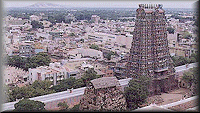


![]()
The origin of mridangam goes back to the Indian mythologies wherein it is stated that
Lord Nandi (the Bull God), who was the escort of Lord Shiva was a master percussionist and used to play the mridangam during the performance of
the " Taandav " dance by Lord Shiva. Another myth adds that that the mridangam apparently was created because
an instrument was needed that could recreate the sound of Indra (the Hindu counterpart of Zeus king of Gods) as
he moved through the heavens on his elephant Airavata. That is why mridangam is
called the 'Deva Vaadyam' or the instrument of the Lords.
Indian music, like every other aspect of Indian culture, reflects centuries of influences and changes wrought during its 3,000 years of recorded history with the immigration of the Aryans from Central Asia in the second millennium B.C. to Islamic invasion in the 12 century B.C. and the British rule from the seventeenth to the twentieth century. With each group came new cultural ideas and technical innovations, and with the passage of time, the new ideas were absorbed and assimilated, emerging finally in an undeniably Indian synthesis. In music this synthesis can be seen in the relationship between ragas (expressive modes) of India and those of the Middle East (the Islamic influence) as also in the talas (cycle of beats).
Indian music, classical, folk or popular, thus reflects layers of metamorphosis. It includes the two styles of classical music - North India's melodious Hindusthani music and the intricate Carnatic Sangeetham of South
India. India can be said to be a country of countries; its diversity of languages, religions, cultures, and traditions have no parallel example anywhere in the world. Indian musical instruments in the same manner are very diverse in nature.
Most of the Indian musical instruments have evolved over centuries. Each instrument has its own history behind its
evolution. In Indian culture's early stages, artifacts, musical instruments, and lifestyles were simple and basic in nature. Example: all tribal instruments are basic rhythm instruments and never complex instruments having a capacity to produce a range of octaves. As a society progressed, the demands on musical instruments arose. Thus, most Indian instruments, although having started in simple forms, because of a long period of evolution, have now become exquisite instruments capable of producing a varied pitch and range of octaves.
Musical instruments, according to ancient works, have been divided into four
types. Thatha, Avanaddha, Sushira and Ghana which are Chordophones,
Membranophones, Aerophones and Idiophones
respectively. The mridangam belongs to the percussion family and has been played by Indians for more than 2000 years. It consists of a wooden shell approximately 27 inches long, covered with stretched skins on each side. It is famous for its distinctive buzzing sound and is used extensively for dance
performances. Mythologically it is believed that God himself created tabla by cutting the mridangam into half.